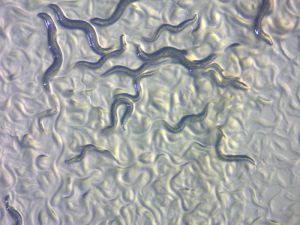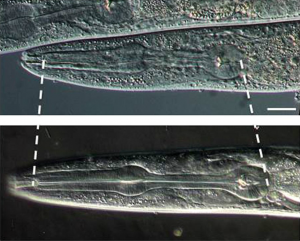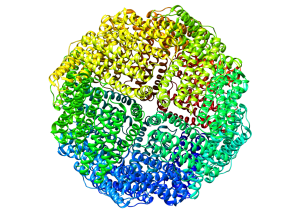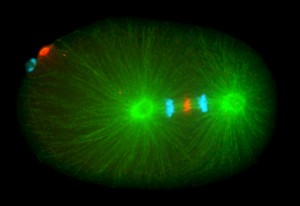Enter your address to receive notifications about new posts to your email.
Articles tagged C. elegans
(32 results)
-
Twenty years of the Worm Art Show
In 1997, Ahna Skop approached her graduate advisor, John G. White, about adding a worm-themed art show to the International C. elegans Conference he was organizing that year. “He said I could do whatever I wanted, but not to involve him,” she recalls. That year marked the very first Worm Art Show, which has since…
-
Jonathan Hodgkin awarded the 2017 Novitski Prize
We are pleased to announce that Jonathan Hodgkin, PhD is the 2017 recipient of the Edward Novitski Prize in recognition of his extraordinary creativity and intellectual ingenuity in solving significant problems in genetics research. Hodgkin uncovered the sex determination pathway in Caenorhabditis elegans, an important and widely used model for animal development and genetics. His…
-
Brighter GFP gets the green light
Off the coast of North America drifts a jellyfish that has unknowingly revolutionized molecular biology. Aequorea victoria produces green fluorescent protein (GFP), a substance that adds a green tinge to the jelly’s bioluminescence, which can sometimes be seen around its margins. By inserting a slightly modified version of the GFP gene into the genomes of…
-
Enhancer-promoter distance is a potent modulator of gene expression
To boost transcription of a target gene, enhancer sequences must make contact with the gene’s promoter. This crucial meeting is mediated by interacting proteins and the formation of chromatin loops that bring distant enhancers and promoters together. Although it’s clear that enhancers increase transcription this way, the primary mechanisms by which an enhancer’s target genes…
-
The tiny worm with a big impact
These worms are as long as a pencil’s tip and only just visible without a microscope. They are among the smallest multicellular animals, but they still have complex organ systems. They are Caenorhabditis elegans, one of the most important organisms in modern biology and a key to understanding the most basic molecular processes of life.…
-
New Faculty Profile: Carolyn Phillips
New Faculty Profiles showcase GSA members who are establishing their first independent labs. If you’d like to be considered for a profile, please complete this form on the GSA website. Carolyn Phillips Gabilan Assistant Professor of Biological Sciences (Since 2015) University of Southern California Lab website Research program: The Phillips lab studies the mechanisms of…
-
New Faculty Profile: Jessica Feldman
New Faculty Profiles showcase GSA members who are establishing their first independent labs. If you’d like to be considered for a profile, please complete this form on the GSA website. Jessica Feldman Assistant Professor (Since 2014) Stanford University Lab website Research program: In my lab we study how cells become properly patterned during development. In…
-
Stretchy cells underlie organ development
Animals’ complex body plans come at a cost: their development is elaborate and must be delicately controlled. One critical aspect of development is size and shape control—every organ needs to fit in its place. The process requires the orchestration of a dizzying number of pathways, and understanding even a single component is far from trivial.…
-
How worms that pump iron get fat
Despite its reputation as an innocent essential mineral, excessive iron intake can be poisonous, and maintaining the proper amount within our cells requires a molecular balancing act among several biochemical pathways. Even at levels that are not overtly toxic, iron overload in humans has been associated with an increased risk of obesity and related conditions,…
-
WormBook comes to GENETICS!
GENETICS’ publication of WormBook in the 21st century is a perfect partnership, because C. elegans research began in GENETICS with the May 1974 publication of Sydney Brenner’s The Genetics of Caenorhabditis elegans – the foundational article that launched an entire field. Since then, some of the most important papers about C. elegans have appeared in…




![By Jim G from Silicon Valley, CA, USA [CC BY 2.0], via Wikimedia Commons](https://s43361.pcdn.co/wp-content/uploads/2017/02/dsc26476-_crystal_jelly_-aequ-300x225.jpg)
![By Kelvinsong (Own work) [CC BY 3.0], via Wikimedia Commons. (Modified)](https://s43361.pcdn.co/wp-content/uploads/2017/01/rsz_transcription_factors-300x163.png)





